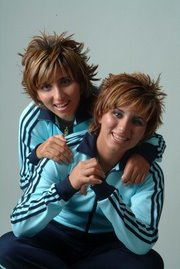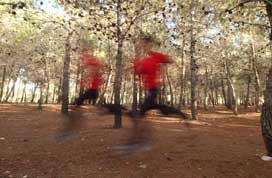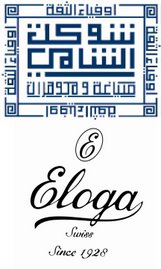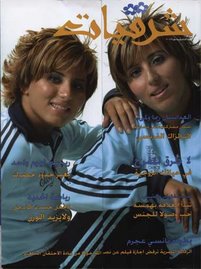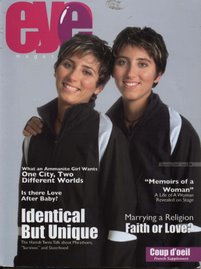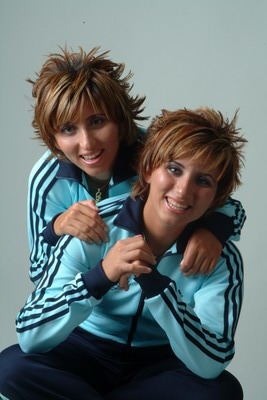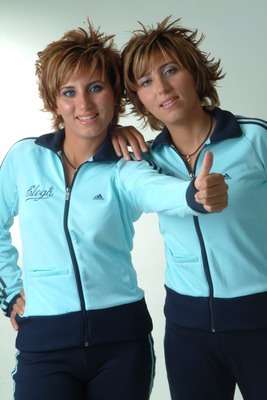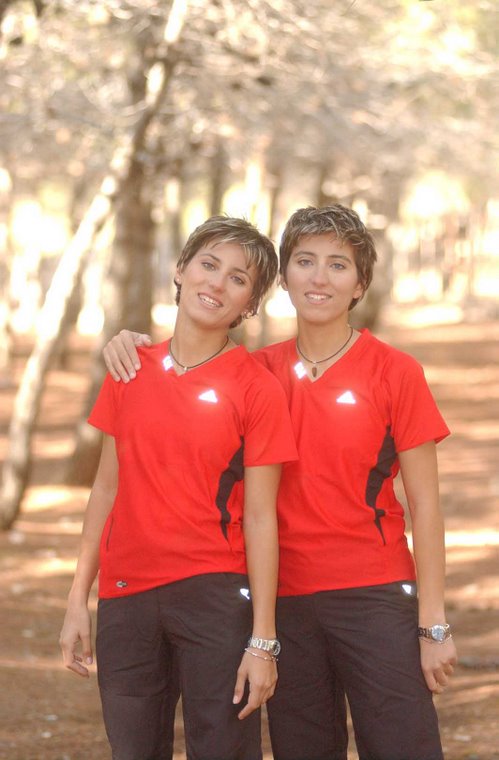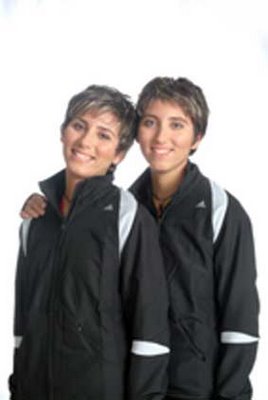 Eye Magazine article on Dec, 2004
Eye Magazine article on Dec, 2004
Identical but Unique The Hattab Twins Talk about Marathons, “Survivor,” and Sisterhood.
Running might have just started out as a hobby for the 23-year-old Hattab twins, Lama and Dima, but it has proven to be much more than that. “Our coach in school always encouraged us to participate in marathons. She saw in us a talent to run, and she predicted that we had it in us to win in major running races,” Lama said. They first experienced the thrill of victory when they took 3rd and 4th place in the Dead Sea Ultra Marathon back in the year 1999, but at the time it was just a sport they wanted to experiment with. Running for a Cause Their love for running went a step further later that year, when they met Dr. Holger Finkernagel while at the camp for the Desert Cup Marathon. Finkernagel heads the World Humanitarian Marathon and Ultramarathon Foundation, a group that organizes marathons around Africa and the Middle East in support of philanthropic causes. “We had just finished taking part in the 21km race,” said Lama. “We started talking with Dr Holger and we got along instantly. We were interested in what he had to say, and he liked o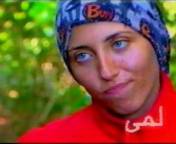 ur ambition. We got around to talking about races, and it was then that we started planning the mission and vision statements behind the Jabal Ishrin marathon.” So, at age 19, Lama and Dima took on the role of head organizers for the Jabal Ishrin, a new marathon to be held in the gorgeous desert of Wadi Rum. The first Jabal Ishrin, run on a trial basis in 2002 and co-sponsored by the Ministry of Tourism and Antiquities, was a success, and the marathon has continued in subsequent years. To fund this event the twins managed to get sponsorships from Red Bull, WHMF, Azeeza, and Adidas. The marathon, in turn, has raised money for the benefit of many worthy causes in Jordan, including the Al Raja School for the Deaf and the Society for the Care of Neurological Patients. Marathon participants have also donated wheelchairs, walkers, and other necessary equipment to those organizations. Now the girls are working on strengthening the media campaign for their marathon, and are striving for official accreditation from the Jordanian Government. “Getting official accreditation will help us get more sponsorships for the event,” said Lama “I want to see the name of the Jabal Ishrin Marathon listed in the Encyclopedia of Best Marathons, for I truly believe that our Marathon is unique.” Nothing is Flawless The 2003 marathon was a great success, the twins said, but the latest race, held last month, was plagued by last-minute problems. The twins had planned a new route for this year that would allow runners to enjoy more of the magical view of the desert. But on the day of the event, they said, the signs marking the route were vandalized. “The road signs were smashed to pieces. Some signs were thrown haphazardly on the track. The water stations were out of reach due to the confusion, and runners had to run great distances without a water supply,” Dima said. “Many of our runners got lost on the way,” Lama added. “We stayed up all night just to make sure that the marathon was a success. It took us four months to prepare for it. On the day of the event, November 18th 2004, we thought everything was planned, but it turned out that everything was a mess.” “I was upset over what happened,” Dima said. “Unlike Lama, I am not prepared to beat myself up over it. We did our best. We worked so many sleepless nights. We had a good cause and most of the people still managed to have fun.” Fortunately, no one was hurt, but the complications the marathon saw this year have made the girls fear losing credibility. “Not
ur ambition. We got around to talking about races, and it was then that we started planning the mission and vision statements behind the Jabal Ishrin marathon.” So, at age 19, Lama and Dima took on the role of head organizers for the Jabal Ishrin, a new marathon to be held in the gorgeous desert of Wadi Rum. The first Jabal Ishrin, run on a trial basis in 2002 and co-sponsored by the Ministry of Tourism and Antiquities, was a success, and the marathon has continued in subsequent years. To fund this event the twins managed to get sponsorships from Red Bull, WHMF, Azeeza, and Adidas. The marathon, in turn, has raised money for the benefit of many worthy causes in Jordan, including the Al Raja School for the Deaf and the Society for the Care of Neurological Patients. Marathon participants have also donated wheelchairs, walkers, and other necessary equipment to those organizations. Now the girls are working on strengthening the media campaign for their marathon, and are striving for official accreditation from the Jordanian Government. “Getting official accreditation will help us get more sponsorships for the event,” said Lama “I want to see the name of the Jabal Ishrin Marathon listed in the Encyclopedia of Best Marathons, for I truly believe that our Marathon is unique.” Nothing is Flawless The 2003 marathon was a great success, the twins said, but the latest race, held last month, was plagued by last-minute problems. The twins had planned a new route for this year that would allow runners to enjoy more of the magical view of the desert. But on the day of the event, they said, the signs marking the route were vandalized. “The road signs were smashed to pieces. Some signs were thrown haphazardly on the track. The water stations were out of reach due to the confusion, and runners had to run great distances without a water supply,” Dima said. “Many of our runners got lost on the way,” Lama added. “We stayed up all night just to make sure that the marathon was a success. It took us four months to prepare for it. On the day of the event, November 18th 2004, we thought everything was planned, but it turned out that everything was a mess.” “I was upset over what happened,” Dima said. “Unlike Lama, I am not prepared to beat myself up over it. We did our best. We worked so many sleepless nights. We had a good cause and most of the people still managed to have fun.” Fortunately, no one was hurt, but the complications the marathon saw this year have made the girls fear losing credibility. “Not  everyone takes complications of this kind lightly,” muttered Lama, but Dima, perpetually cheery, chimed in: “The bright side of it all was that some people ran the half marathon without knowing they had it in them. They thought that they were running a shorter distance, but the misleading directions forced them to discover new capabilities they didn’t even know they had.” Inseparable From Their Sport, and From Each Other Lama and Dima are the oldest of five siblings. They said that their father, a dentist and their mother, a general practitioner, have always worried about them. Their mother pleaded with them time and time again not to be involved in such strenuous activities, but the girls’ love for sports made it hard for them to abide by their parents wishes. “We are sometimes forced to tell our mother about the sports we are involved in after we are involved in them,” Dima said. “That way we don’t have to put up with all her worrying.” The girls had always been in the same class at school. Lama says Dima picks out her clothes, which are often identical to her own. They had even always worn the same hairstyle. “When I put blonde streaks in my hair, I told my sister to do the same,” Dima said. “She didn’t want to at first, but she did.” Their dedication to the marathon, and their bond with one another as sisters led them to study by correspondence. “We both hold degrees in IT, which we got together,” said Lama. “Distance learning was the only way to go, if we were to organize a major event like this one every year.” Today the girls work together in the corporate world. At home they are inseparable, and while organizing the marathon’s proceedings they work side by side with a team of volunteers to ensure that the event is a success. In the future they said, they hope to provide more support for the physically challenged, and to do something to benefit the diabetic community in Jordan. Separated by a TV Show “We both wanted to be on ‘Survivor,’” Dima said. “Lama was more into it than me, and she was chosen to go to Lebanon for the final casting. My parents were not very keen on only sending one of us out, but eventually they gave in, and Lama went, while I stayed here in Amman.” The twins had always striven for identical goals in life, and had never had to live apart. When Lebanon’s LBC broadcasting chose only Lama to be on the show, the idea of separation in itself was a big challenge for them. “Being on the show was an interesting experience,” Lama said. “We were only allowed to have with us one pair of trousers, one pair of shorts, two pairs of underwear, a pair of sneakers, and a pair of hiking boots. We spent the first few nights on the deserted island without sleep, as we were under the threat of being attacked by monkeys. I remember going seven days without food, as we only lived on the fruits available to us from the land.” Lama eventually had to leave the show because she gets an injury on one of the game. When she returned to Amman, she had lost 7 kilos, Dima said. “When I first came back I kept eating chocolates as if they were going to leave the planet” said Lama. “When she was not eating chocolates she was crying about the way in which she had left the show,” Dima added. “If I had left the show because I was defeated I could have lived with that,” Lama said, “but what was hard for me to bear was that I was forced to leave the program this way. I felt I was representing Jordan, and by leaving the show so abruptly, I felt that I had let my country down.” Lama till this day speaks bitterly about the program, and claims that she is happy that her sister didn’t have to go through the experience: “Now that I look back on it, the experience isn’t great, but it is a good representation of life. We as people are like the contestants on Survivor. We do whatever it takes to survive. In life the strongest survives, and the strongest is not necessarily the most ethical. I did many things for my team: I found the fire, and I found the food and water, but because I didn’t play the role of the hero I was out of the game. I am better for my team than many people who are still in the game, but in life the law of the jungle prevails, and it is the law of the jungle that made me leave the program the way I did.” Being so emotionally attached, the girls naturally felt a great void existed in their lives while being apart. “When Lama was gone I spoke about her so much at work that people would accidentally call me Lama,” said. She said that she had to keep herself busy just so that she didn’t have to think so much about Lama when she was gone. Lama had similar feelings. She said that when she was on the island, she spoke about her sister so much that people called her Dima. Together to Complete Each Other Outside the running scene and the television studio, the twins are quick to point out that there are differences in their personalities. Dima claims that her sister is sometimes harsh with people. Lama on the other hand, said that Dima is too laid back, and that she is not prepared to bother herself with details. “Dima irritates me when we are organizing a marathon. I would be worrying about the smallest details, and she would be watching TV as if she has no care in the world,” she said Dima said, “I do care about details, but I do let things go, and I do allow myself to have a break every once in a while.” Though the twins argue at times, they also make up instantly. “We never get upset at the same time,” said Dima. “One of us is upset, and the other remains calm.” “That way,” Lama added, “the calm one helps the other see things for what they are.” Both girls hold strong bonds with their family, but Lama says that she puts the family first. ”Whenever there is a problem in a family they usually ask me to solve it,” she said. “I do care about the family,” Dima said, “but I am always sure that in one way or another they will work things out.” Despite, or perhaps because of, their different priorities, the twins say they feel they complete each other. People see them as identical in appearance, but it is the bonds they share—as sisters, as athletes, and as philanthropists – that make them unique.
everyone takes complications of this kind lightly,” muttered Lama, but Dima, perpetually cheery, chimed in: “The bright side of it all was that some people ran the half marathon without knowing they had it in them. They thought that they were running a shorter distance, but the misleading directions forced them to discover new capabilities they didn’t even know they had.” Inseparable From Their Sport, and From Each Other Lama and Dima are the oldest of five siblings. They said that their father, a dentist and their mother, a general practitioner, have always worried about them. Their mother pleaded with them time and time again not to be involved in such strenuous activities, but the girls’ love for sports made it hard for them to abide by their parents wishes. “We are sometimes forced to tell our mother about the sports we are involved in after we are involved in them,” Dima said. “That way we don’t have to put up with all her worrying.” The girls had always been in the same class at school. Lama says Dima picks out her clothes, which are often identical to her own. They had even always worn the same hairstyle. “When I put blonde streaks in my hair, I told my sister to do the same,” Dima said. “She didn’t want to at first, but she did.” Their dedication to the marathon, and their bond with one another as sisters led them to study by correspondence. “We both hold degrees in IT, which we got together,” said Lama. “Distance learning was the only way to go, if we were to organize a major event like this one every year.” Today the girls work together in the corporate world. At home they are inseparable, and while organizing the marathon’s proceedings they work side by side with a team of volunteers to ensure that the event is a success. In the future they said, they hope to provide more support for the physically challenged, and to do something to benefit the diabetic community in Jordan. Separated by a TV Show “We both wanted to be on ‘Survivor,’” Dima said. “Lama was more into it than me, and she was chosen to go to Lebanon for the final casting. My parents were not very keen on only sending one of us out, but eventually they gave in, and Lama went, while I stayed here in Amman.” The twins had always striven for identical goals in life, and had never had to live apart. When Lebanon’s LBC broadcasting chose only Lama to be on the show, the idea of separation in itself was a big challenge for them. “Being on the show was an interesting experience,” Lama said. “We were only allowed to have with us one pair of trousers, one pair of shorts, two pairs of underwear, a pair of sneakers, and a pair of hiking boots. We spent the first few nights on the deserted island without sleep, as we were under the threat of being attacked by monkeys. I remember going seven days without food, as we only lived on the fruits available to us from the land.” Lama eventually had to leave the show because she gets an injury on one of the game. When she returned to Amman, she had lost 7 kilos, Dima said. “When I first came back I kept eating chocolates as if they were going to leave the planet” said Lama. “When she was not eating chocolates she was crying about the way in which she had left the show,” Dima added. “If I had left the show because I was defeated I could have lived with that,” Lama said, “but what was hard for me to bear was that I was forced to leave the program this way. I felt I was representing Jordan, and by leaving the show so abruptly, I felt that I had let my country down.” Lama till this day speaks bitterly about the program, and claims that she is happy that her sister didn’t have to go through the experience: “Now that I look back on it, the experience isn’t great, but it is a good representation of life. We as people are like the contestants on Survivor. We do whatever it takes to survive. In life the strongest survives, and the strongest is not necessarily the most ethical. I did many things for my team: I found the fire, and I found the food and water, but because I didn’t play the role of the hero I was out of the game. I am better for my team than many people who are still in the game, but in life the law of the jungle prevails, and it is the law of the jungle that made me leave the program the way I did.” Being so emotionally attached, the girls naturally felt a great void existed in their lives while being apart. “When Lama was gone I spoke about her so much at work that people would accidentally call me Lama,” said. She said that she had to keep herself busy just so that she didn’t have to think so much about Lama when she was gone. Lama had similar feelings. She said that when she was on the island, she spoke about her sister so much that people called her Dima. Together to Complete Each Other Outside the running scene and the television studio, the twins are quick to point out that there are differences in their personalities. Dima claims that her sister is sometimes harsh with people. Lama on the other hand, said that Dima is too laid back, and that she is not prepared to bother herself with details. “Dima irritates me when we are organizing a marathon. I would be worrying about the smallest details, and she would be watching TV as if she has no care in the world,” she said Dima said, “I do care about details, but I do let things go, and I do allow myself to have a break every once in a while.” Though the twins argue at times, they also make up instantly. “We never get upset at the same time,” said Dima. “One of us is upset, and the other remains calm.” “That way,” Lama added, “the calm one helps the other see things for what they are.” Both girls hold strong bonds with their family, but Lama says that she puts the family first. ”Whenever there is a problem in a family they usually ask me to solve it,” she said. “I do care about the family,” Dima said, “but I am always sure that in one way or another they will work things out.” Despite, or perhaps because of, their different priorities, the twins say they feel they complete each other. People see them as identical in appearance, but it is the bonds they share—as sisters, as athletes, and as philanthropists – that make them unique.











